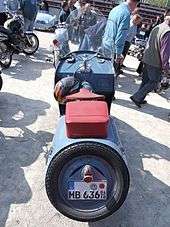Maico Mobil
The Maico Mobil is an early touring motorcycle made by Maico between 1950 and 1958. Conceived and marketed as a “car on two wheels”, the Mobil had body panels that enclosed the drivetrain, protected its riders from the elements, and included an integral pair of panniers and a mount for a spare tyre.[1][2]
 Maico Mobil | |
| Manufacturer | Maico |
|---|---|
| Also called | Maicomobil |
| Production | 1950-1958 |
| Assembly | Pfäffingen, Germany |
| Class | Touring motorcycle |
| Engine | two-stroke single-cylinder engine |
| Transmission | MB150 & MB175 – 3-speed with twist grip control MB200 – 4-speed with heel-and-toe pedal |
| Frame type | tubular steel space frame |
| Suspension | Front: telescopic forks Rear: Swingarm with coil spring and damper |
| Tires | 3.00-14, front and rear |
| Fuel capacity | 8.5 L |
| Oil capacity | petrol/oil mixture |
| Related | Maicoletta |
Frame, body, and suspension

The Mobil had a tubular steel space frame on to which steel and aluminum body panels were bolted. A large front fairing enclosed the front wheel.[1][2] Mounted on the fairing were a transparent plastic windscreen that wrapped around the handlebars, a dashboard through which the steering column protruded,[1][2] and lower panels containing a glovebox and provision for a car radio to be installed.[1] Mounted on the dashboard were the ignition switch, the speedometer, and the fuel filler cap;[1][2] the fuel tank was mounted to the frame under the dashboard.[1]
The rear bodywork included a pair of integral panniers and a rear mount for a spare wheel. The panniers were accessed by unlatching a panel under the pillion.[1][2]
The Mobil used telescopic front forks and a rear swingarm.[2]
Engine and transmission
The Mobil originally had a 150 cc single-cylinder two-stroke engine[1] mounted between the dashboard and the rider's seat.[1][2] Access panels on both sides of the Mobil could be removed to work on the engine. Power was transmitted through a three-speed transmission operated by a twist grip.[1]
The capacity of the Mobil's engine was increased to 175 cc in 1953. An optional 200 cc became available in 1955, the same year that the three-speed twist-grip controlled transmission was replaced by a four-speed transmission controlled by a heel-and-toe pedal shifter.[1]
References
| Wikimedia Commons has media related to Maicomobil. |
- Gerrit-Klaas Berghuijs (2003). "Scooters Van Toen - Hun tijd vooruit: MaicoMobil & Maicoletta" [Scooters of the Past - Ahead of their time: MaicoMobil & Maicoletta]. Het MotorRijwel (in Dutch). The Hague, Netherlands: Stichting Historische Motor Documentatie (66): 38–40. ISSN 0929-094X.
- Webster, Mike (1997). "Maico Mobil". Classic Scooters. Parragon Book Service. pp. 44–45. ISBN 978-0-7525-2082-7.
Further reading
- "Road Test - 197cc Maico Mobil". The Motor Cycle. 97 (2793). 25 October 1956.